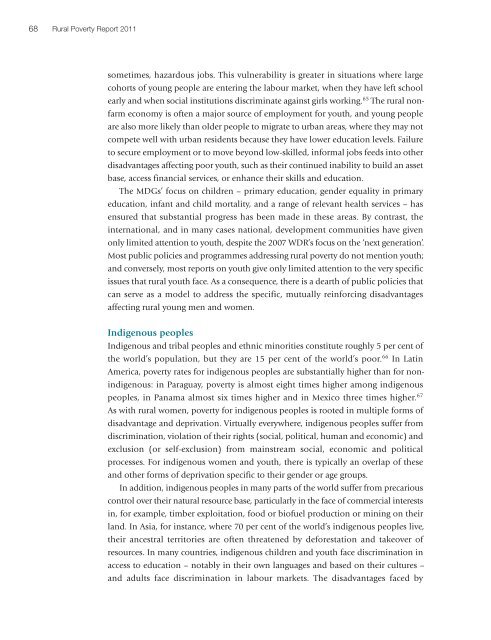English - IFAD
English - IFAD
English - IFAD
Create successful ePaper yourself
Turn your PDF publications into a flip-book with our unique Google optimized e-Paper software.
68<br />
Rural Poverty Report 2011<br />
sometimes, hazardous jobs. This vulnerability is greater in situations where large<br />
cohorts of young people are entering the labour market, when they have left school<br />
early and when social institutions discriminate against girls working. 65 The rural nonfarm<br />
economy is often a major source of employment for youth, and young people<br />
are also more likely than older people to migrate to urban areas, where they may not<br />
compete well with urban residents because they have lower education levels. Failure<br />
to secure employment or to move beyond low-skilled, informal jobs feeds into other<br />
disadvantages affecting poor youth, such as their continued inability to build an asset<br />
base, access financial services, or enhance their skills and education.<br />
The MDGs’ focus on children – primary education, gender equality in primary<br />
education, infant and child mortality, and a range of relevant health services – has<br />
ensured that substantial progress has been made in these areas. By contrast, the<br />
international, and in many cases national, development communities have given<br />
only limited attention to youth, despite the 2007 WDR’s focus on the ‘next generation’.<br />
Most public policies and programmes addressing rural poverty do not mention youth;<br />
and conversely, most reports on youth give only limited attention to the very specific<br />
issues that rural youth face. As a consequence, there is a dearth of public policies that<br />
can serve as a model to address the specific, mutually reinforcing disadvantages<br />
affecting rural young men and women.<br />
Indigenous peoples<br />
Indigenous and tribal peoples and ethnic minorities constitute roughly 5 per cent of<br />
the world’s population, but they are 15 per cent of the world’s poor. 66 In Latin<br />
America, poverty rates for indigenous peoples are substantially higher than for nonindigenous:<br />
in Paraguay, poverty is almost eight times higher among indigenous<br />
peoples, in Panama almost six times higher and in Mexico three times higher. 67<br />
As with rural women, poverty for indigenous peoples is rooted in multiple forms of<br />
disadvantage and deprivation. Virtually everywhere, indigenous peoples suffer from<br />
discrimination, violation of their rights (social, political, human and economic) and<br />
exclusion (or self-exclusion) from mainstream social, economic and political<br />
processes. For indigenous women and youth, there is typically an overlap of these<br />
and other forms of deprivation specific to their gender or age groups.<br />
In addition, indigenous peoples in many parts of the world suffer from precarious<br />
control over their natural resource base, particularly in the face of commercial interests<br />
in, for example, timber exploitation, food or biofuel production or mining on their<br />
land. In Asia, for instance, where 70 per cent of the world’s indigenous peoples live,<br />
their ancestral territories are often threatened by deforestation and takeover of<br />
resources. In many countries, indigenous children and youth face discrimination in<br />
access to education – notably in their own languages and based on their cultures –<br />
and adults face discrimination in labour markets. The disadvantages faced by

















